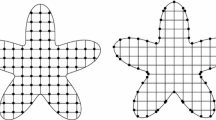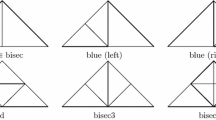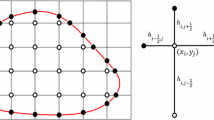Abstract
The Shortley–Weller method is a standard central finite-difference-method for solving the Poisson equation in irregular domains with Dirichlet boundary conditions. It is well known that the Shortley–Weller method produces second-order accurate solutions and it has been numerically observed that the solution gradients are also second-order accurate; a property known as super-convergence. The super-convergence was proved in the \(L^{2}\) norm in Yoon and Min (J Sci Comput 67(2):602–617, 2016). In this article, we present a proof for the super-convergence in the \(L^{\infty }\) norm.


Similar content being viewed by others
References
Caffarelli, L.A., Gilardi, G.: Monotonicity of the free boundary in the two-dimensional dam problem. Annali della Scuola Normale Superiore di Pisa-Classe di Scienze 7(3), 523–537 (1980)
Chorin, A.J.: A numerical method for solving incompressible viscous flow problems. J. Comput. Phys. 135(2), 118–125 (1997)
Ciarlet, P.G., Miara, B., Thomas, J.M.: Introduction to Numerical Linear Algebra and Optimisation. Cambridge Texts in Applied Mathematics. Cambridge University Press, Cambridge (1989)
Friedman, A.: Variational principles and free-boundary problems. Courier Corporation, North Chelmsford (2010)
Gibou, F., Min, C.: Efficient symmetric positive definite second-order accurate monolithic solver for fluid/solid interactions. J. Comput. Phys. 231, 3245–3263 (2012)
Gustafsson, I.: A class of first order factorization methods. BIT 18, 142–156 (1978)
Harlow, F.H., Welch, J.E.: Numerical calculation of time-dependent viscous incompressible flow of fluid with a free surface. Phys. Fluids 8(3), 2182–2189 (1965)
Iserles, A.: A First Course in the Numerical Analysis of Differential Equations. Cambridge Texts in Applied Mathematics. Cambridge University Press, Cambridge (1996)
Li, Z.-C., Hu, H.-Y., Wang, S., Fang, Q.: Superconvergence of solution derivatives of the shortley-weller difference approximation to poisson’s equation with singularities on polygonal domains. Appl. Numer. Math. 58(5), 689–704 (2008)
Ng, Y.T., Chen, H., Min, C., Gibou, F.: Guidelines for poisson solvers on irregular domains with dirichlet boundary conditions using the ghost fluid method. J. Sci. Comput. 41(2), 300–320 (2009)
Peskin, C.S.: Flow patterns around heart valves. In: Proceedings of the Third International Conference on Numerical Methods in Fluid Mechanics, pp. 214–221. Springer (1973)
Shortley, G.H., Weller, R.: The numerical solution of Laplace’s equation. J. Appl. Phys. 9(5), 334–348 (1938)
Strikwerda, J.C.: Finite Difference Schemes and Partial Differential Equations. SIAM, New Delhi (2004)
Weynans, L.: A proof in the finite-difference spirit of the superconvergence of the gradient for the Shortley–Weller method. Ph.D. thesis, INRIA Bordeaux (2015)
Xiu, D., Karniadakis, G.E.: A semi-Lagrangian high-order method for Navier–Stokes equations. J. Comput. Phys. 172(2), 658–684 (2001)
Yoon, G., Min, C.: Analyses on the finite difference method by Gibou, et al. for poisson equation. J. Comput. Phys. 280, 184–194 (2015)
Yoon, G., Min, C.: Convergence analysis of the standard central finite difference method for Poisson equation. J. Sci. Comput. 67(2), 602–617 (2016)
Yoon, G., Min, C., Kim, S.: A stable and convergent method for hodge decomposition of fluid-solid interaction. (2016). arXiv:1610.03195
Author information
Authors and Affiliations
Corresponding author
Appendix: Detailed Calculations in Lemma 4.3
Appendix: Detailed Calculations in Lemma 4.3
In this section, we provide detailed calculations that lead to the estimate \(\left\| D_{x}^{h}c^{h}\right\| _{L^{\infty }\left( \tilde{\Omega _{o}^{h}}\right) }\le \frac{105}{4}\max _{\tilde{\Omega },\left| \alpha \le 5\right| }\left| \partial ^{\alpha }u\right| \cdot h^{2}\) in Lemma 4.3.
Using the Taylor series of \(u\left( x,y\right) \) at \(\left( x_{i+\frac{1}{2}},y_{j}\right) ,\) the terms that sum up \(D_{x}^{h}c^{h}\) in (4) are expanded. For notational conveniences, the local coordinates centered at \(\left( x_{i+\frac{1}{2}},y_{j}\right) \) are used in the calculations. For example, \(u_{i+1,j+1}\) is denoted by \(u\left( \frac{h}{2},h\right) \). The Taylor expansions are listed below with remainders.

When the above expansions are inserted into the summation of \(D_{x}^{h}c^{h}\), canceled out all the terms but the remainders.
Now, we prove the lemma.
Rights and permissions
About this article
Cite this article
Seo, J., Ha, Sy. & Min, C. Convergence Analysis in the Maximum Norm of the Numerical Gradient of the Shortley–Weller Method. J Sci Comput 74, 631–639 (2018). https://doi.org/10.1007/s10915-017-0458-z
Received:
Revised:
Accepted:
Published:
Issue Date:
DOI: https://doi.org/10.1007/s10915-017-0458-z




